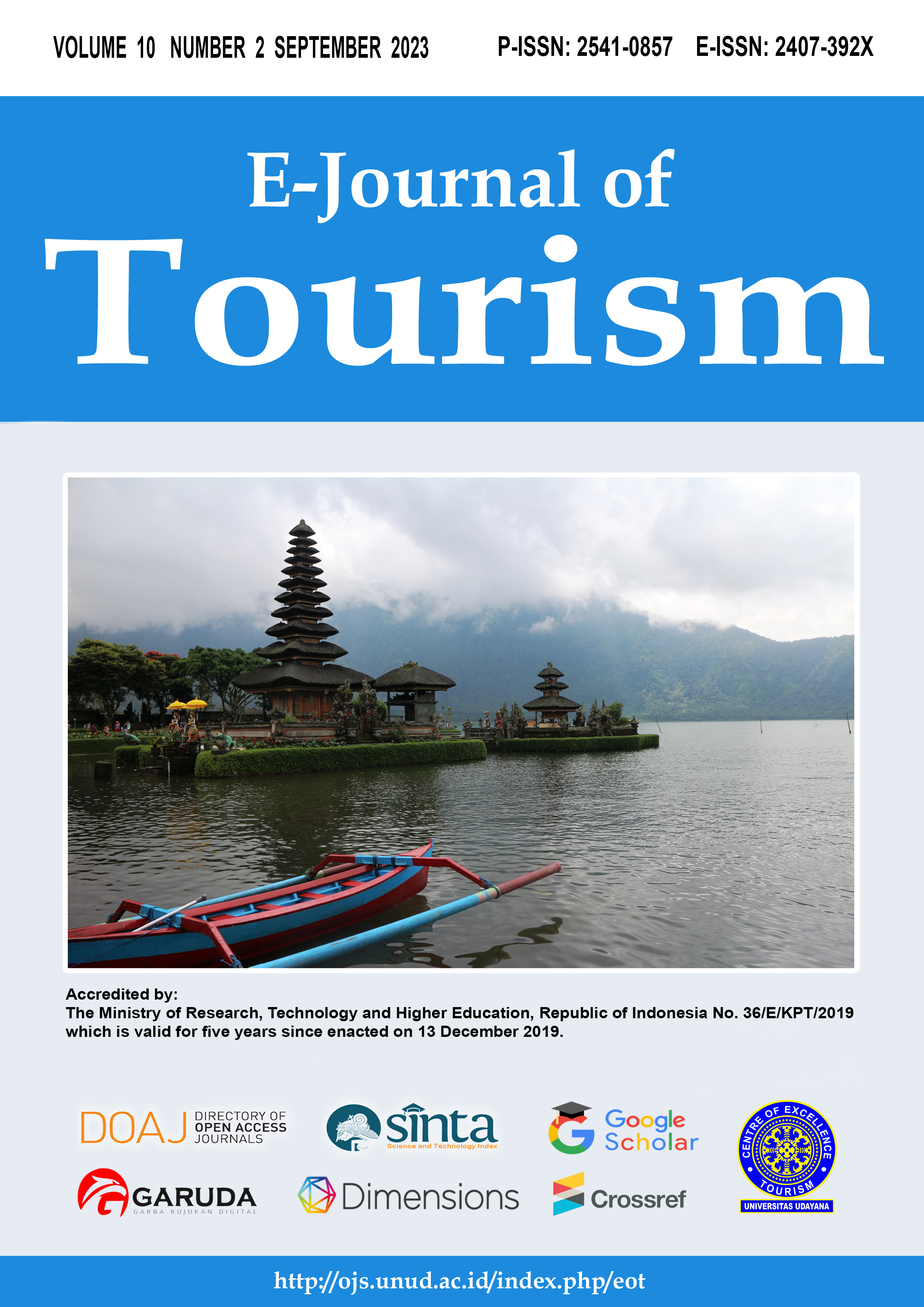The Suitability Level of Ecotourism Characteristics in the Sipin Lake Tourist Destination in Jambi City
Abstract
The activity of tourism has more potential to be a new income source in an area with tourism destination. The united nations world tourism organization (UNWTO) released the number of world tourism activities in 2018, which reached 1.4 billion. Global development, including tourism development, is guided by the SDGs. The form of increasingly dynamic tourism activities cannot be separated from the existence of attractions, amenities, accessibility, and institutional services. Jambi City has the tourism object of Sipin Lake as a potential tourism destination that has yet to be developed maximally to have high competitiveness. The research aims to assess the suitability level of ecotourism aspects at the Sipin Lake tourist destination. The analysis method used is a quantitative method using the Importance-Performance Analysis (IPA) method. The average result of the level of suitability of all variables of the characteristics of ecotourism is 60%, where attractions (61%), accessibility (101%), amenities (61%), institiutional services (42%), and environmental conservation (34%).
Downloads
References
Arismayanti, N. K., Sendra, I. M., Suwena, I. K., Budiarsa, M., Bak-ta, I. M., & Pitana, I. G. (2019). Tourism Villages’ Development in Bali, Mass or Alternative Tour-ism? Journal of Tourism and Hos-pitality Management, 7(2), 117–139. https://doi.org/10.15640/jthm.v7n2a11
Boley, B. B., & Green, G. T. (2016). Ekowisata and natural resource conservation: The potential for a sustainable symbiotic relation-ship. Journal of Ekowisata, 15(1), 36–50. https://doi.org/10.1080/14724049.2015.1094080
Boley, B. B., McGehee, N. G., & Ham-mett, A. T. (2017). Importance-performance analysis (IPA) of sustainable tourism initiatives: The resident perspective. Tourism Management, 58, 66-77.
Butarbutar, R., & Soemarno, S. (2013). Environmental Effects Of Ekow-isata In Indonesia. Journal of In-donesian Tourism and Develop-ment Studies, 1(3), 97–107. https://doi.org/10.21776/ub.jitode.2013.001.03.01
Copper, Fketcher, J., Gilbert, D., & Wan-hill, S. (1995). Tourism, Princi-ples and Prantice. London: Log-man
Dahmiri, D., & Khalik, I. (2022). Strategi Pengembangan Destinasi Wisata Danau Sipin Jambi. Jurnal MEBIS (Manajemen Dan Bisnis), 7(1), 27–36. https://doi.org/10.33005/mebis.v7i1.312
Hampton, M. P., & Jeyacheya, J. (2020). Tourism-Dependent Small Is-lands, Inclusive Growth, and the Blue Economy. One Earth, 2(1), 8–10. https://doi.org/10.1016/j.oneear.2019.12.017
Mandić, A., Mrnjavac, Ž., & Kordić, L. (2018). Tourism infrastructure, recreational facilities and tourism development. Tourism and hospi-tality management, 24(1), 41-62
Martilla, J. A., & James, J. C. (1977). Im-portance-performance analy-sis. Journal of marketing, 41(1), 77-79.
Mazrekaj, R. (2020). Impact of road in-frastructure on tourism develop-ment in Kosovo. International Journal of Management, 11(4).
Mishra.K.Prabuddh. (2021). Environmen-tal Conservation and Manage-ment. July, 186–187. https://www.researchgate.net/publication/353164121
Nguyen, Q. H. (2021). Impact of invest-ment in tourism infrastructure de-velopment on attracting interna-tional visitors: A nonlinear panel ARDL approach using Vietnam’s data. Economies, 9(3). https://doi.org/10.3390/economies9030131.
Nunes, L. J., Raposo, M. A., & Gomes, C. J. P. (2020). The impact of tour-ism activity on coastal biodiversi-ty: a case study at praia da cova redonda (Algarve—Portugal). Environments, 7(10), 88.
[OECD] Organisation for Economic Co-operation and Development. (2020). The territorial impact of COVID-19 : Managing The Crisis Across Levels of Government. Organization Fo Economic Coop-eration and Development, April, 2–44. https://www.oecd.org/coronavirus/policy-responses/the-territorial-impact-of-covid-19-managing-the-crisis-across-levels-of-government-d3e314e1/
Schreurs, M. A. (2012). Rio +20: Assessing Progress to Date and Future Challenges. Journal of Environment and Development, 21(1), 19–23. https://doi.org/10.1177/1070496511436277
Scott, N., Cooper, C., & Baggio, R. (2008). Destination Networks. Annals of Tourism Research, 35(1), 169–188.
Siti, F., Agung, K., Wawan, I. G., & Mun-tadliroh. (2013). Pedoman Fasili-tator untuk Pembangunan Ekow-isata.
Sugiyono. (2018). Metode Penelitian Kombinasi (Mixed Methods). Bandung: CV Alfabeta.
Supranto, J. 2006. Pengukuran Tingkat Kepuasan Pelanggan untuk Menaikkan Pangsa Pasar. Rineka Cipta. Jakarta
Surya, C. R. (2016). Pengelolaan Ekow-isata Berbasis Goa: Wisata Alam Goa Pindul. Deepublish. Yogya-karta
UNWTO. (2020). International tourism growth continues to outpace the global economy.
Utami, L. S. S., Setyanto, Y., & Windu-wati, S. (2016). Strategic Public Relations in Building Brand Im-age Eco-Tourism Lombok. In In-ternational Conference on Media, COmmunications, and Sociology (Issue December). https://www.researchgate.net/profile/Yugih-Setyan-to/publication/311950758_Strategic_Public_Relations_in_Building_Brand_Image_Eco-tour-ism_Lombok/links/58646f0c08ae6eb871ad0748/Strategic-Public-Relations-in-Building-Brand-Image-Eco-tourism-Lombok.pdf#page=4
Varghese, B., & Paul, N. I. J. (2014). a Literature Review on Destination Management Organization (Dmo) Bindi Varghese*; Neha Itty Jose Paul**. ZENITH International Journal of Multidisciplinary Re-search, 4(12), 82–88. http://ssrn.com/abstract=2686970
Wallace, G. N. and Pierce, S. M. (1996), An evaluation of ekowisata in Amazonas, Brazil, Annals of Tourism Research 23: 843-873
Wondirad, A., & Ewnetu, B. (2019). Community participation in tour-ism development as a tool to fos-ter sustainable land and resource use practices in a national park milieu. Land Use Policy, 88(August), 104155. https://doi.org/10.1016/j.landusepol.2019.104155
Zou, Y., & Yu, Q. (2022). Sense of safety toward tourism destinations: A social constructivist perspective. Journal of Destination Marketing and Management, 24.

This work is licensed under a Creative Commons Attribution 4.0 International License.
The copyright of the received article shall be assigned to the journal as the publisher of the journal. The intended copyright includes the right to publish the article in various forms (including reprints). The journal maintains the publishing rights to the published articles.




















